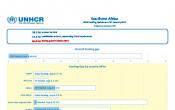Botswana
Operation: Botswana
Location
{"longitude":25,"latitude":-22,"zoom_level":0}
Latest update of camps and office locations 21 Nov 2016. By clicking on the icons on the map, additional information is displayed.
Key Figures
| 2016 end-year results | |
| 2,350 | refugees and asylum-seekers received monthly food assistance |
| 563 | PoC children were enrolled in primary and secondary schools |
| 332 | refugees had access to anti-retroviral treatment |
| 82 | refugees departed for resettlement |
| 2017 planning figures | |
| 100% | of primary school-aged children will be enrolled in primary education |
| 60% | of people of concern with specific needs will receive in-kind support |
| 50% | of people of concern opting for local integration will be locally integrated |
Latest Updates
People of Concern
25%
Increase in
2016
2016
| 2016 | 2,832 |
| 2015 | 2,265 |
| 2014 | 2,847 |

[["Refugees",2093],["Asylum-seekers",80],["Others of concern",659]]
Loading ...
Botswana
< Back
2016
{"categories":[2013,2014,2015,2016,2017,2018],"budget":[5.45758951,5.03058637,4.351907414,3.33321459,3.0763196,null],"expenditure":[3.39488248,2.73602506,2.54778802,2.19748654,null,null]}
{"categories":[2013,2014,2015,2016,2017,2018],"p1":[5.45758951,5.03058637,4.351907414,3.33321459,3.0763196,null],"p2":[null,null,null,null,null,null],"p3":[null,null,null,null,null,null],"p4":[null,null,null,null,null,null]}
{"categories":[2013,2014,2015,2016,2017,2018],"p1":[3.39488248,2.73602506,2.54778802,2.19748654,null,null],"p2":[null,null,null,null,null,null],"p3":[null,null,null,null,null,null],"p4":[null,null,null,null,null,null]}
Loading ...
CHOOSE A YEAR
- 2015
- 2016
- 2017
Working environment
The asylum space in Botswana remains limited due to the policies restricting the movement of refugees and asylum-seekers to Dukwi camp. Asylum applications in the country have a high rejection rate and local integration prospects for refugees are very limited. In addition, some 400 asylum-seekers have been detained at the Centre for Illegal Immigrants for more than one year, with no solution to their plight in sight. UNHCR continues to advocate for fair and efficient asylum processes as well as the relocation of detained asylum-seekers to Dukwi camp.UNHCR continued to implement its phase-out plan and scaled down its presence in Botswana throughout 2016. The Office has reduced the number of implementing partners and works closely with the Botswana Red Cross Society.
Population trends
- Botswana hosts 2,114 refugees and 731 asylum-seekers of 15 different nationalities.
- Main countries of origin are Namibia and Zimbabwe.
Achievements and impact
- The Government of Botswana initiated the review of the Refugee and Control Act of 1968.
Unmet needs
- UNHCR was not able to identify a legal partner to provide legal assistance to refugees.
- Medical care provided to people of concern by the Government does not include life-saving anti-retroviral treatment.
- Refugees do not have machine-readable convention travel documents.
- There is a lack of access to tertiary education for people of concern.
Operational context and population trends
Though people of concern to UNHCR enjoy unfettered access to Botswana, those awaiting refugee status determination (RSD) are detained. Once status has been conferred, refugees are encamped, with limited freedom of movement and few self-reliance opportunities owing to legislative restrictions on employment.Key priorities in 2016
- Prioritizing activities related to durable solutions, in particular voluntary repatriation and resettlement
- Providing basic needs and essential services, including access to potable water, sanitation, health and education services, as well as community empowerment and self-reliance opportunities
- Transitioning from food distribution to cash based interventions
- Advocating for a favourable protection environment related to personal security and freedom from exploitation.



